Vol 1 No. 35 TROPIC LIGHTNING NEWS October 21, 1966
Index
[Many of the photographs in this issue of Tropic Lightning News were too dark
or blurry to reproduce clearly. They have been included only to give a
sense of the activities in the Division.]
2nd Bde. Scores
Ope. 'Sunset Beach' Ends
"Sunset Beach," a five-week operation conducted by the division's 2nd
Brigade, was concluded recently after netting a total of 80 Viet Cong killed in
action.
"Tropic Lightning" infantrymen also captured 46 VC, 21 Weapons, 1307 rounds
of small arms ammunition and 11,400 pounds of rice.
The 2nd Brigade's three Infantry battalions covered Hau Nghia Province during
the pacification maneuver. Working in coordination with the joint (ARVN-US)
Operations Center in the province headquarters at Bao Trai, the 2nd Bn., 27th
Inf., operated from the division's base camp at Cu Chi.
"Wolfound" elements used airmobile assaults in conjunction with local ARVN
units to discover an arms factory, a VC hospital and a number of rice, and
ammunition caches.
The brigade's 1st "Wolfhound" Battalion worked in the Trang Bang area
approximately 10 miles northwest of Cu Chi. Conducting both airmobile and
ground missions from a command post set up outside the village, the battalion
uncovered and destroyed a massive underground way-station capable of housing a
VC battalion.
In their part of "Sunset Beach," the armored personnel carriers of the 1st Bn.
(Mech), 5th Inf., swept through the Ho Bo Woods, north-northwest of Cu Chi, on
way to operations in the lower sections of the Boi Loi Woods. In addition to
tunnels, weapons and caches, the infantrymen found and destroyed a heavily
fortified VC rest camp.
Westy Pays Visit To Pleiku
Gen. W.C. Westmoreland, Commander, U.S. Military Assistance Command, Vietnam,
spoke briefly to the staff officers of the 3rd Brigade, then presented a Silver
Star to Capt. Charles H. Armstrong in a brief ceremony at the brigade forward
command post.
Gen. Westmoreland complimented the officers and men of the 3rd Brigade Task
Force for their fine record and professionalism.
"The 3rd Brigade is carving a good name for itself here," he said.
Capt. Armstrong, 28-year-old aviation operations officer for the brigade, was
cited for heroism in close combat against the Viet Cong.
He received his country's third highest award for valor for his actions as
company commander of Co. C, 1st Bn., 14th Inf., on March 20.
His company, on a search and-destroy mission, encountered approximately 20
Viet Cong. The company's main force set up a blocking position, while Capt.
Armstrong led an enveloping force and closed with the enemy. After a 45-minute
battle, 19 Viet Cong were killed and one was captured.
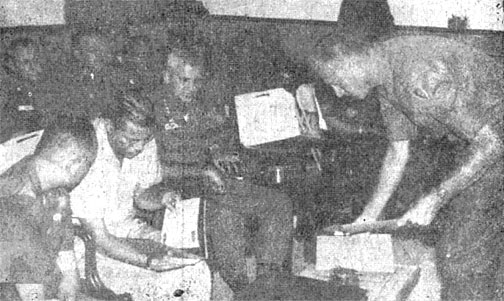 |
| BRIEFING - Maj. Gen. Fred C. Weyand, division commander, reaches for folders of propaganda leaflets to give Secretary of Defense Robert S. McNamara and Gen. W.C. Westmoreland, commander, U.S. Military Assistance Command, Vietnam, during a briefing at Cu Chi. (Photo by PFC Doug Kearney) |
McNamara Stops at Cu Chi During 4-Day Tour o f Vietnam
Defense Secretary Robert S. McNamara, on the last leg of a four-day tour of
Vietnam, recently visited the 25th Infantry "Tropic Lightning" Division at Cu
Chi.
Arriving at the Cu Chi airfield in late afternoon, McNamara was welcomed by
Maj. Gen. Fred C. Weyand, division commander, and Brig. Gen. George G. O'Connor,
assistant division commander.
The defense secretary was then taken to division headquarters for
discussions, illustrations and examples of the division's revolutionary
development program in Hau Nghia Province.
McNamara was accompanied by Arthur Sylvester, Assistant Secretary of Defense
for Public Affairs; Lt. Gen. Nguyen Huu Co, Vietnam's. Deputy Prime Minister;
Gen. W. C. Westmoreland, commander, Military Assistance Command, Vietnam, and
Lt. Gen. Jonathan O. Seaman, commander, II Field Force, Vietnam.
Wolfhounds Help ARVNs Attack by Helicopter
The 1st Bn., 49th Regt., Army, Republic of Vietnam, (ARVN) got its first
chance to operate with the aid of helicopters recently, thanks to the 2nd Bn.,
27th Inf., "Wolfhounds."
The ARVN unit had never been on an operation using helicopters and wanted to
learn. The 2nd Battalion had ARVN officers, with the help of the 2nd Bn., work
with helicopters on several missions. Then came the day when the ARVN were
ready to try an airmobile mission on their own.
Arrangements were made for the helicopters and early in the morning, the
ships began to lift 200 troops to the area of operation.
The command ship, which controls action on the ground, carried the ARVN
commander and his radioman, the unit's American advisor and advisors from the
Wolfhounds. The landing went well and the air support was effective.
While on the ground, the ARVNs killed one Viet Cong and captured one weapon
and several hand grenades. After a successful day, the ARVNs had their first
try at setting up an extraction location.
With the help of the Wolfhound advisors, the landing zone was set up and the
extraction begun.
All went well and before long all of the Vietnamese unit was back at its
jumping-off point with a little more knowledge on the use of helicopters.
1/14th Adopts Montagnards
The 1st Bn., 14th Inf., has adopted the Montagnard village of Plei Yt.
When the 14th Infantry "Golden Dragons" moved into an area of operations near
the village, Lt. Col. Gilbert Procter Jr., battalion commander, decided to show
the villagers that the Golden Dragons were better friends than the Viet Cong.
For months, VC had stolen the villagers' rice and anything else of value.
Col. Proctor called a conference with Maj. Joseph Hoyt, battalion operations officer; Capt. Richard H. Beal,
battalion intelligence officer; Capt. Michael Sparago, battalion surgeon, and
Maj. Michael Filip, brigade Catholic chaplain. They discussed a civil affairs
program to help the villagers.
When asked what his people needed to improve conditions, the village chief
said an adequate water system, but the present project of hauling sand for a
purification system was slow-going because the sand had to be carried in small
baskets on their backs.
Btry. B, 2nd Bn., 9th Arty., volunteered its ¾-ton truck for hauling the
sand.
The villagers pitched in, using the sand to fill in a swampy area near the
water point.
Chaplain Filip arrived one morning with several boxes of clothes, soap, and
other useful items were taken into the village and distributed.
Capt. Beal mixed a large vat of strawberry and cherry flavored kool-aid for
the villagers. He got several weird looks, but the villagers soon discovered
the strange drink mix tasted good.
While the clothing and soap were being passed out, Doctor Sparago and PFC
Kenneth Williams, a 14th Infantry medic, set up an aid line to examine and treat
the sick.
Before the men of the Golden Dragons departed, Capt. Beal asked the
interpreter to find out what else the village needed.
It was disclosed they needed food and hand tools.
Doctor Sparago said he knew where these items could be procured so he set off
for the sector headquarters in Pleiku.
He returned a few hours later with several 100-pound bags of wheat, three
rolls of blanket material, several cases of soybean oil and a large bundle of
hand tools.
Every day for two weeks a team of medics treated the villagers and the
effects began to show. Soap was curing skin sores and the other medications
were cleaning up numerous other infections.
The day before the Golden Dragons departed the area, the village chief and
three of his men were invited to have supper with the American officers.
As the Golden Dragons moved to another landing zone, they saw that their
civic action had done some good. The villagers were doing an extraordinary
thing, a thing which committed them to the war and could invite retaliatory
measures from the Viet Cong. They were hanging a sign at the entrance to Plei
Yt which read "Friends of the 1st Bn., 14th Inf."
Page 2 TROPIC LIGHTNING NEWS October 21, 1966
Decorated
| DISTINGUISHED FLYING CROSS | |
|
Maj. Charles R. Sandidge, HHD, 25th Avn. Bn. Maj. John A Scattergood, HHB, 25th Avn. Bn. Capt. Ira L. Hartwell Jr., Co. A, 25th Avn. Bn. Capt. Robert H. Kelley, Co. A, 25th Avn. Bn. |
Capt. Danny L. Romig, Co. A, 25th Avn. Bn. 1st Lt. William M. Chastain, Co. A, 25th Avn. Bn. Sp4 Lawrence G. Large, Trp. D, 3rd Sqdn., 4th Cav. Sp4 Patrick B. Shea, Co. B, 25th Avn. Bn. |
|
BRONZE STAR MEDAL WITH 'V' DEVICE |
|
|
PSgt. Carl E. Skeens Sr., Co. A, 1st Bn., 27th Inf. SSgt. Robert L. Little, Co. A, 1st Bn., 27th Inf. Sgt. Donald L. Baker, Co. A, 1st Bn., 27th Inf. Sp4 Bernard Dillard, Co. A, 1st Bn., 27th Inf. (Posthumously) Sp4 Harvey A. Goode, HHC, 1st Bn. (Mech), 5th Inf. Sp4 Charles E. Heath, Co. A, 65th Engr. Bn. (Posthumously) |
Sp4 Bernard Janowsky, Co. B, 1st Bn. (Mech), 5th Inf. Sp4 Daniel A. Locke, Co. A, 2nd Bn., 27th Inf. PFC Kenneth H. Branaman, Co. A, 1st Bn. 27th Inf. (Posthumously) PFC Jack Brown, Co. A, 1st Bn., 27th Inf. (Posthumously) PFC Robert W. Ruhl, Co. A, 1st Bn., 27th Inf. (Posthumously) PFC Lawrence H. Wilson, Co. A, 1st Bn., 27th Inf. (Posthumously) |
| AIR MEDAL WITH 'V' DEVICE |
|
| Maj. Nicholas H. Doiron, Trp. D, 3rd Sqdn., 4th Cav. | |
|
PURPLE HEART |
|
|
SFC Juan R. Galvan, Co. B, 2nd Bn., 14th Inf. Sgt. Richard M. Baron, Co. B, 2nd Bn., 14th Inf. Sgt. Ronald M. Molden, Trp. A, 3rd Sqdn., 4th Cav. Sgt. Don W. Socia, Trp. A, 3rd Sqdn., 4th Cav. Sp5 Peter A. Kunz, HHT, 3rd Sqdn., 4th Cav. |
Sp4 Ralph A. Atkins, Co. B, 2nd Bn., 14th Inf. Sp4 Roger M. Gertken, Trp. A, 3rd Sqdn., 4th Cav. Sp4 Victor Rodriguez-Sosa, Co. B, 2nd Bn., 14th Inf. PFC Tommy R. Stefi, Trp. A, 3rd Sqdn., 4th Cav. PFC James D. White, Trp. D, 3rd Sqdn., 4th Cav. |
Why Money Order Sales Are Controlled In VN
(Editor's note: This is the third in a series on authorized currency and the
black market in Vietnam.)
Q : Is there any limit to the amount we can make out in postal money orders?
A : Yes. In any one month, the most you can buy in money orders is the full
amount of money you draw in the command, your net pay for the month. Your commanding officer may
authorize you to buy additional money orders only after being satisfied that the
MPG were obtained lawfully, such as from the sale of personal property or on
proof of savings.
Q : Why are money orders controlled?
A : Money orders are controlled to prevent their being used for the illegal
export of funds from Vietnam. Like dollar bills or checks, money orders are
negotiable dollar instruments. Before the present restrictions were imposed on
money orders, large amounts of money were going from Vietnam to U.S. Mail
facilities. Troops were sending the funds for persons not authorized to use the
facilities or to export money. As in the case of other illegal currency
transactions, this money was being used for personal profit, to finance
smuggling and black market operations or being diverted to communist hands.
Q : How about green dollars I might get in the mail?
A: You must convert them immediately, because possession of U.S. dollars is
forbidden for U.S. troops here. Don't worry about where someone might think you
got it - just convert it right away, at an authorized conversion point.
Q: What happens to dollars that get on the black market?
A : Black market dollars can end up as payments for communist weapons and
supplies. U.S. dollars are gathered here and elsewhere, smuggled to places like
Hong Kong and funneled into Red China or other communist countries. The
communists have major accounts with many international banks, contracts with
many munitions suppliers throughout the world. In effect the dollars you place
into the black market pool in Vietnam could pay for the gun and bullets that
kill you. And it makes no difference whether you put green dollars or MPG in
illegal hands; the effect is the same. Other uses of the black market money
already have been mentioned. Some is smuggled out of Vietnam for personal gain;
some is used to finance other smuggling and black market operations.
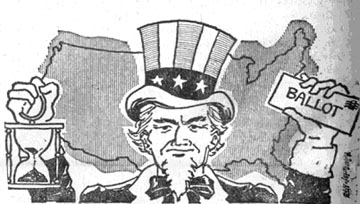 Editorial
Editorial
Time's Running Out
Are you prepared and ready to join your countrymen election-day as they go to
the polls and vote?
You should be. By now your absentee ballot should have arrived. You have
studied your state's candidates and their qualifications. You are now ready to
exercise your most priceless possession, the right to vote!
Just how priceless that possession really is, can prove elusive and hard to
grasp. We take our country for granted. But a top winner in a recent Freedoms
Foundation Letter Awards Program cleared away some of the cobwebs when he summed
it up this way:
"Our American concept of democracy is built on the ability of government by
consent of the governed. This power of each individual American is expressed at
the voting booth; there begins government, the strength of the Union. America
is only as strong as the American voter, and power exists only where it is
exercised. Don't lose your vote, use it!"
That's a very good thumbnail explanation of why we should vote. And the
last sentence sums it up. Unless you use your vote, it is lost.
Don't put, off mailing your absentee ballot. Mark it and mail it now.
(AFNB)
Move Out On Xmas Mail
Military personnel presently serving in Vietnam should plan to mail their
Christmas gifts early to facilitate their arrival prior to the holiday.
If the sender intends to use the regular postage rates gifts should be mailed
no later than November 10. If the sender decides to use air mail postage, his
gifts should be mailed not later than December 10.
Armed Forces personnel are cautioned that all packages should be securely
wrapped and properly addressed in order to insure delivery to its destination in
time.
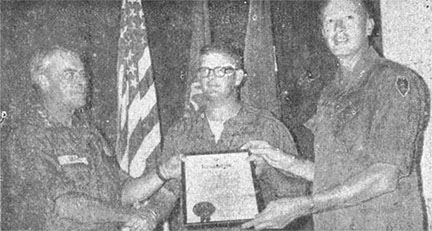 |
RESOLUTION - Gen. Dwight Beach, commanding general, U.S. Army, pacific (l), and Maj. Gen. Fred C. Weyand, commanding general, 25th Infantry Division (r), present a resolution from the City of Honolulu, extending it's wishes for a victorious and safe return to each and every member of the 1st Bn., 27th Inf., "Wolfhounds" to Maj. Halvor Myrah, executive officer, 1st Bn., 27th Inf. (Photo by Sp5 Jose Finklea) |
| The TROPIC LIGHTNING NEWS is an
authorized publication of the 25th Infantry Division. It is published
weekly for all division units in the Republic of Vietnam by the
Information Office, 25th Infantry Division, APO U.S. Forces 96225.
Army News Features, Army Photo Features and Armed Forces Press Service
material are used. Views and opinions expressed are not necessarily
those of the Department of the Army. Printed in Saigon, Vietnam, by
The Saigon Daily News. Maj. Gen. Fred C. Weyand . . . . Commanding General Maj. William C. Shepard . . . . . . Information Officer 1st Lt. William H. Seely III . . . . Officer-in-Charge Sp4 David L. Kleinberg . . . . . . . Editor Sp4 Adrian E. Wecer . . . . . . . . Editorial Assistant |
Page 3 TROPIC LIGHTNING NEWS October 21, 1966
Dog Honored At Pleiku
A five-year-old, 105-pound German named Turk received the Purple Heart at
Pleiku for being wounded in combat in Vietnam.
He accepted his award like a soldier. He sat erect while the commander, Lt.
Col. Gilbert Proctor Jr. of the 1st Bn., 14th Inf., taped the medal to his
chest. Turk barked gratefully as he accepted Co. A's congratulations.
Turk, an Army-trained German Shepherd on duty with the division's 3rd Brigade
Task Force, was "working" an area to the front of a 14th Infantry patrol when
his handler, SFC Russell L. Castle of Woodbridge, Va., commanded him to cross a
small stream and search the other side.
Fell
Turk obeyed, but, while scrambling up the steep bank, he fell into a punji
pit and landed on his right shoulder.
He was lifted back to a veterinarian on the next resupply helicopter and
treated. The next day he was again "working" with Co. A.
"Turk is one of the best scout dogs I have," said 2nd Lt. Robert Thackery,
scout dog platoon leader.
Good Nose
"He works easy," said Sgt. Castle. "He's got a good nose. He'll find
anything if it's out there. That punji wound was a freak accident. On normal
ground Turk would have discovered it, but that slope was steep and slick and he
couldn't get his footing."
"Turk's a Godsend," said Col. Proctor. "He's uncovered countless punji pits
that would have probably otherwise injured my boys. Just having a trained dog
working in front of a patrol is a great confidence builder. He gets along well
with the men and pulls his own weight. Someday he'll provide a warning that'll
help us win a battle and save lives."
Turk didn't understand all this ceremony. He was just a dog doing his job.
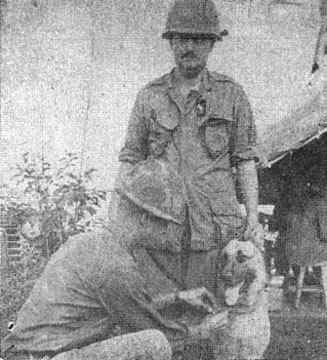 |
TOP DOG - Turk receives the Purple Heart from Lt. Col. Glibert Procter Jr. while Turk's handler, Sgt. Russell L. Castle, looks on. (Photo by Sp5 Dale V. Sutphin) |
1/14th PFC Reports A UFO
PFC James Van Horn of 1st Bn., 14th Inf., was on guard in a bunker on the 3rd
Brigade Task Force perimeter recently. Said PFC Van Horn, "Sometimes when
you're on guard, it seems as though a tree is moving or a bush becomes a man."
However, at about 2:30 in the morning, he saw something altogether
different. He could do nothing but blink his eyes when he saw the telephone in
the bunker fly out the bunker window.
PFC Van Horn jumped up and looked down at the spot where the telephone had
been. He then stuck his head and his M-16 rifle out the opening.
He found the telephone several feet away to his front.
The rest of the night, PFC Van Horn guarded his post and the telephone.
That morning he told some of the men who had been on guard about the
incident.
"That was just the Sergeant. He tripped on the wire when he was checking the
guard."
`Polar Bears' Warm Up Hamlet
"Polar Bears" entered the hamlet of Ap Thai Thuong near Tay Ninh recently but
no one seemed to be terrified by their presence.
These "Polar Bears" were men of the 4th Bn., 21st Inf., 196th Light Infantry
Brigade, entering to set up their medical civic action program.
A team headed by Capt. Leonard W. Martinec, battalion surgeon, went to work
setting up its "little dispensary" in one of the villager's homes.
Almost immediately the people flocked to the aid station. By noon, more than
140 patients had been treated, and still the lines continued to grow outside the
dispensary.
After the break for lunch, the medical team continued its work until the last
patient had been examined.
Capt. Martinet commented that most of the people whom they treated had minor
ailments.
"We administer antibiotics now, and when we rotate back to this village in a
couple of weeks we can continue the medication. Of course, the more serious cases are forwarded to the
province hospital."
Sp6 Bennie Perez, one of Capt. Martinet's assistants, said, "Besides treating
individual ailments, such as skin condition, colds and sore throats, we try to
make sure that each patient we treat is given vitamins to help overcome the
damage done by malnutrition."
"If we can continue to administer vitamins to the people, they will be less
susceptible to more serious diseases."
After treating more than 200 patients, the "Polar Bears" packed up their
supplies and headed for home, promising the village chief they would return
soon. The villagers shouted and waved good-bye. No one seemed too afraid of
the "Polar Bears."
Almost Civilization
Touches of civilization come slowly to units serving in Vietnam, and the
196th Light Infantry Brigade at Tay Ninh has learned just how slow that is.
One of the biggest morale boosters is a recent movie from back home. An
exciting movie with a pretty girl can transport a man away from the rigors and
hardships of jungle warfare to a third-row seat in his neighborhood theater -
almost.
"Chargers" of the 196th were recently treated to their first movie since
arriving here more than a month ago. Special Services offered the movie "Young
Cassidy" to the eager men of the 3rd Bn., 21st Inf.
The first reel had been shown and the second was just beginning when the men
suddenly found themselves swimming in a flash downpour.
Hardly like home.
196th Adds Punch - Four Big Guns
The 196th Light Infantry Brigade "Chargers" now have an added punch in the
form of four heavy artillery pieces.
Btry. C, 2nd Bn., 32nd Arty., has brought two 175mm guns into the base camp.
The two are "Cassius" and "Cyclops VI."
"Doom Dinger" and "Delta Devils," two eight-inch howitzers, have just arrived
with Btry. D, 3rd. Bn., 13th Arty.
The new pieces increase the range and capability of the brigade.
| AID - A medic treats a wounded soldier from the 2nd Bn., 14th Inf., "Battle Dragons", during a recent operation. (Photo by PFC Vern Shibla) | 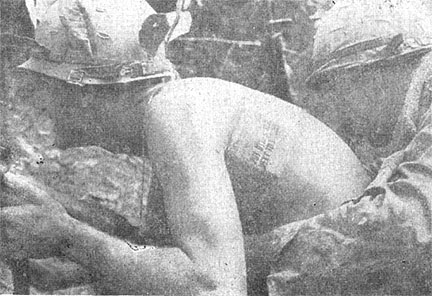 |
Page 4-5 TROPIC LIGHTNING NEWS October 21, 1966
[This issue of Tropic Lightning News was scanned from a bound library volume provided by the 25th Infantry Division Museum. Portions of the photographs and stories on pages 4 and 5 are missing. They were printed across the center of the 2-page-wide sheet and were hidden from sight because of the way the paper is bound into the book - the book could not be safely opened wide enough to see that part of the page.]
THE CHILDREN SHALL BE LED BY HOT DOGS
Schools Lead, Bands Will Follow
Nothing tastes better than an American hot dog, smothered in mustard and
wrapped in a bun.
Even Vietnamese youngsters raised on rice and nuoc mam, are starting to give
them a try as the
American pacification program adds punch (and hot dog) in its arsenal.
From hot dogs, to new schools and band performances, the division is
promoting good will in Hau Nghia province.
Pictures taken by SFC Joe Hawkins of the 25th Div. Arty. capture both the
puzzlement and delight of Duc Hue children, beginning the experiment of eating
strange American food.
Other shots record other facets of the program, a program that's beginning to
go over as well as American hot dogs.
| DE-TRUCK - Capt. Charles, B. Foster, project officer for Special Forces Detachment D-35, helps children from trucks as they arrive for the National Children's Holiday Festivities at Duc Hue District Headquarters. (Photo by SFC Joe Hawkins) |
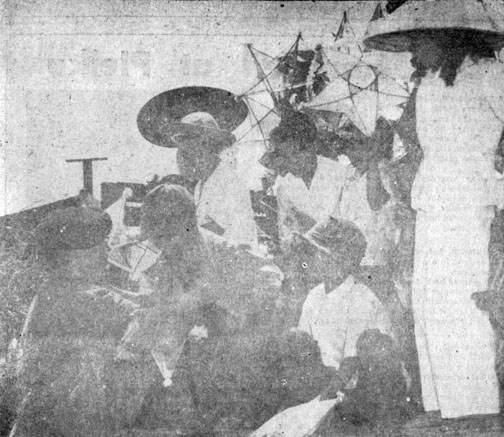 |
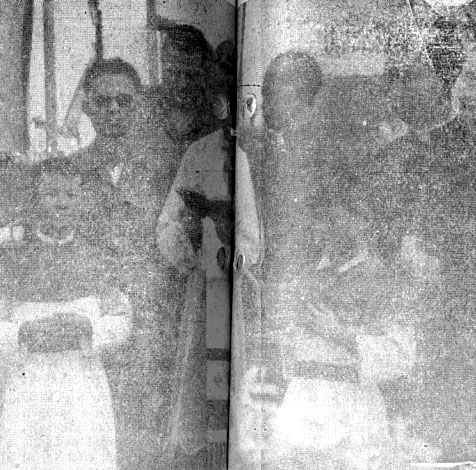 |
BLESSES - Bishop Thieu of Binh Duong, Tay Ninh, Hau Nghia and Long An Province, blesses a new trade school that opened near the division's base camp in the hamlet of Bac Ha I. (missing) Lowe, commander, division Support Command, represented the division at the ceremony. (Photo by Sp5 Robert Williams.) |
| CHOP CHOP - Vietnamese children enjoy hot dogs and American soft drinks at the National Children's Holiday Festivities held recently at Duc Hue District Headquarters. (Photo by SFC Joe Hawkins) |
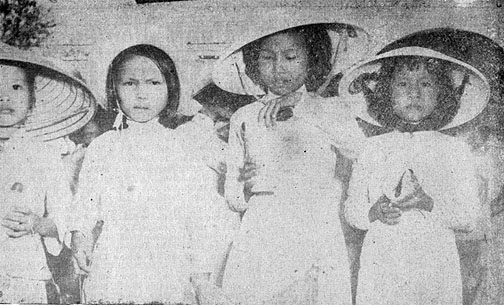 |
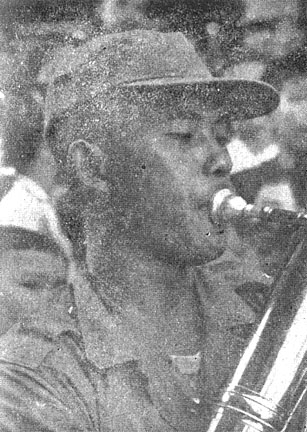 |
PUCKERS - A division band member as he entertains the crowd during a civic action project of the 2nd Bn., 27th Inf. (Photo by SSgt. Al Batungbacal) |
| JOINING IN - The division's band joins musically in the celebration of the opening of a new trade school in the hamlet of Bac Ha I just outside the division's base camp perimeter. (Photo by Sp5 Robert Williams) |
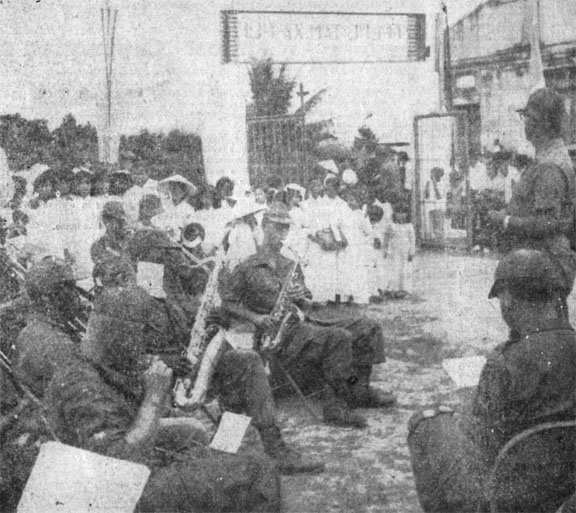 |
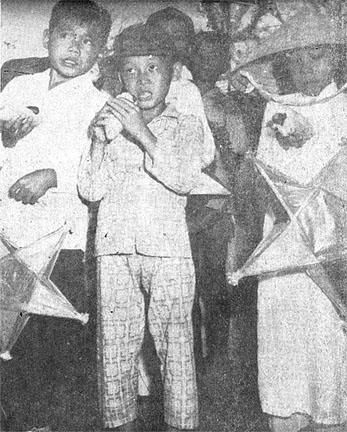 |
A WHAT DOG? - Vietnamese children enjoy hot dogs at the National Children's Holiday Festivities held recently at Duc Hue District Headquarters, 25 miles northwest of Saigon. Festivities were sponsored by a Special Forces Detachment and the division's 1st Bn., 8th Arty. (Photo by SFC Joe Hawkins) |
Page 6 TROPIC LIGHTNING NEWS October 21, 1966
Many Months of Work
Chapel Dedicated
More than 125 men of the 25th attended a dedication service at the new
Essayons Memorial Chapel, 65th Engr. Bn., recently.
The service began with a call to worship by Chaplain (Capt.) Alfred DeLossa
Jr., battalion chaplain. Lt. Col. Carroll D. Strider, commanding officer,
welcomed all those attending the service and commented on the success of the
new chapel. The dedicatory address was given by Chaplain Lt. Col. Alexander L.
Paxson, Division Chaplain.
Construction on the new chapel was started in May. The original plans were
drawn by 2nd Lt. Ronald E. Heck, Co. C, 65th Engr. As the building progressed
slowly, the plans were modified by Chaplain DeLossa and Lt. Heck until the
present design was achieved.
Obtaining building materials proved to be a very difficult task. "I've had
to do quite a bit of 'horse trading'," said Chaplain DeLossa.
Much of the gravel, sand, and cement was donated by Air Force and Navy units
in Saigon and Tan Son Nhut. Nothing was supplied by the division. Items such
as bricks, the blue sky lights and the memorial plaque were purchased in Cu Chi.
"All the money for these items was received through donations and we haven't
spent more than $400 on the entire project," Chaplain De Lossa said.
Work on the chapel was done on a voluntary basis. Since some of the men work
at their jobs at night, there were often four or five working on the chapel
during the day. "We had many loyal workers," said the chaplain.
When the chapel was completed, it was somewhat of a surprise to everyone
involved. Its modern design was very appealing since it differed from the
native construction of many buildings on base camp.
The name of the chapel, "Essayons," is a French word meaning "let us try,"
which is the motto of Corps of Engineers. The chapel will seat between 175 to
200 people, and is a memorial to those soldiers of the 65th who have lost their
lives in Vietnam.
Sp4 McFauling Likes Hunting
Sp4 Jimmy C. McFauling of C Trp., 3rd Sqdn., 4th Cav., a part of the 3rd
Brigade Task Force, likes to hunt. Back home in the Dallas, Texas, area, Jimmy hunted deer and quail . . . but
in Vietnam, he hunts not only Viet Cong, but peacocks as well.
He has killed, cooked, and eaten six peacocks in the past few weeks and has
shared them with his buddies.
"It isn't under glass, but it sure tastes a lot like pheasant," said one
stuffed friend.
725th Defeats Viets - In Volleyball Game
Six men of Co. D, 725th Maint. Bn., at Pleiku found themselves in a rough
two-hour "battle" with the Vietnamese recently.
"This battle" was not one for life and death, but rather for their unit's
prestige.
The six men composed the company's volleyball team.
They were in a heavily contested game against a team representing the Army,
Republic of Vietnam's 821st Ordnance Company from Pleiku.
Although the Americans had a height advantage, they lost the opener of three
games, 15 to 11.
With their backs against the wall, the Americans won the final two, 15-7 and
1508.
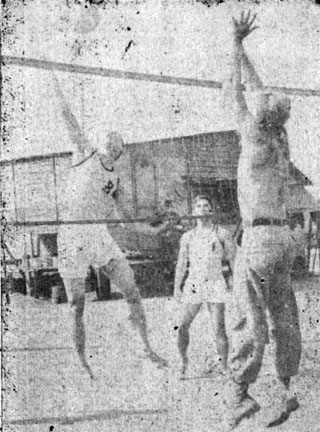 |
IN-COMING ROUND - Six men from Co. D, 725th Maint. Bn., and the Republic of Vietnam's 821st Ordnance Company from Pleiku, tangle in a volleyball game. In a best-of-three series, the 725th won, 11-15, 15-6 and 15-8. (Photo by Sgt. Mike Ilorowitz) |
SFC Supplies Arty. Ammo At Pleiku --- And Plenty
SFC James E. Millsap, the ammunition supply sergeant for the 3rd Brigade's
2nd Bn., 9th Arty., supplies ammunition for the battalion's 105mm howitzer
firing batteries.
The "Mighty Ninth" Artillery has fired more than 133,000 rounds since it
arrived in Vietnam last January.
Supplying the firing batteries with ammunition day and night requires long
working hours in all kinds of weather.
As Sgt. Millsap says, "If every round of ammo that we have fired since
arriving in Vietnam were laid end-to-end, it would form a line approximately 75
miles long. That's one heck of a lot of explosives dropping on the enemy."
Hahn Scores Ace at Pleiku
The airstrip of 3rd Brigade Task Force forward command post was turned into a
golf course for about an hour recently for the Paul Hahn show.
Hahn, a comedian with golf clubs, spent the first half of the show conducting
a golf clinic. The second half of the show, which Hahn has performed on
nationwide television, consisted of trick golf shots with unusual clubs.
Several hundred members of the brigade, including the brigade commander,
Brig. Gen. Glenn D. Walker, viewed the show.
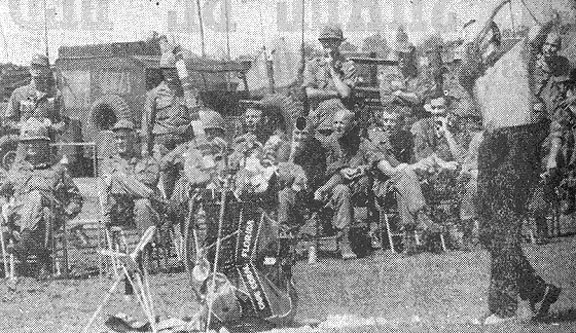 |
| H + I - Paul Hahn, a comedian with golf clubs, spent the first half of the show conducting a golf clinic. The second half of the show, which Hahn has performed on nationwide television, consisted of trick golf shots with unusual clubs. (Photo by Sgt. Mike Horowitz) |
The Company Calls To Say Thanks
By PFC Dan Desmond
PFC Morris Monnin, 24, of Phoenix sat in the ground surveillance bunker of
the 1st Bn., 27th Inf., recently as he had many other nights during operations.
It seemed as if he were in for a long dull night, waiting for a foreign sound
to be picked up by his receiver and relayed into his headset.
PFC Chris Spada, 18, of Mount Holly, N.J., was with him and as it got later
their conversation gave way to the sounds of night that poured through their
earphones.
Suddenly a snoring sound came over the air. PFC Monnin knew it well. "I'm
picking something up," he said to PFC Spada.
"How many ?"
"It sounds like about a squad. Check the companies and find out if they have
an ambush in that area now.
PFC Spada contacted the companies and found there was a patrol in the area.
"It's one of ours," he told PFC Monnin. "I got something else. It's on the
same path as our patrol but three to six more," replied PFC Monnin, "and they're
coming toward our wires. Ask the company if the patrol is returning."
A few minutes later, PFC Spada turned to PFC Monnin and told him the company
didn't know anything about it.
"Better tell Sgt. Austin," he continued.
Sgt. Dan Austin of Rugby, N.D., the surveillance team chief, grabbed his ear
sets and listened.
"Yeah, I got both groups. The patrol is settled now and the second group is
circling around them. I'll tell the company, and they can handle it from here,"
he told PFC Spada.
Sgt. Austin called the company.
In the distance, a lot of firing broke out.
"I wonder what that is," said PFC Monnin.
Minutes later, after the firing stopped, the phone buzzed. Sgt. Austin
answered it and in a few seconds turned to his men smiling.
"That was the company," he said. "They just called to thank us for helping
them get those VC. They killed one and found blood trails leading away."
Page 7 TROPIC LIGHTNING NEWS October 21, 1966
2/14th Closes Operation 'Kamuela'
Operation Kamuela came to a successful conclusion recently as the 2nd Bn.,
14th Inf., "Battle Dragons" swept deep into Viet Cong-infested jungles to strike
its devastating blow for the division.
At the end of the two-week operation, 13 VC lay dead but, more important, 230
tons of bagged enemy rice had been uncovered, the largest rice haul ever found
by elements of the 1st Brigade. More than 100 tons of rice was salvaged and
evacuated for distribution to Vietnamese villagers.
"The jungle was extremely thick," said Sgt. Ralph M. Graff, 22, of
Portsmouth, Ohio, as he recounted one of the many actions during the operation.
"We could hardly make headway, but pushed and pulled our way through."
On reaching their planned destination and finding nothing, the squad swung
around and began its long push back. It was almost mid-day and the the sun was
shining directly down through the dense foliage.
"As we started our return sweep, I saw something shining out of the brush.
It was one of those corrugated tin roofs the Vietnamese use on their
structures," Sgt. Graff explained.
Moving his squad in closer, Sgt. Graff began securing the area for the rest
of the on-coming platoon.
"We could then see huge sacks under the roof," continued the sergeant. "I
knew immediately what we had found. I never saw so much rice."
Inside of the 20 by 30 foot tin-roofed shelter lay more than 30 tons of
stored enemy rice. It had been the largest cache the operation claimed to that
point. But moments later, Sgt. Graff hit pay dirt again.
Just 100 yards away another such shelter was found. This one was somewhat
more camouflaged, but with the sun at high-noon it was easily spotted. Bag upon
bag had been neatly stacked under its roof. A quick count of the bags showed
that 30 more tons had been captured.
"The view of the area and conditions of the bags gave us the impression that
the rice was ready to be moved," said Sgt. Graff, "but there was no sign of VC
anywhere."
At that very moment, some 500 yards south, the point squad of the 3rd platoon
was receiving heavy sniper fire. Sgt. Raymond G. Horne, 19, of Rockingham,
N.C., directed his squad forward immediately. The Viet Cong had made the error
of disclosing their position, and Sgt. Horne's point squad was ripping into the
bushes in hot pursuit.
Although the enemy withdrew without heavy loses, they had left behind
hundreds of tons of rice that would ultimately feed the free people of the
republic.
| CHOP CHOP - Division troops and local Vietnamese workers store captured Viet Cong rice. The 280 tons of rice captured will be distributed to Vietnamese villagers. |
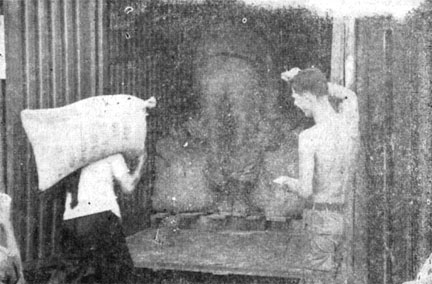 |
Cpl. 'Takes 5' on Nest of Viper - Result: Another Snake Story
Cpl. John F. Crowe, having prepared his defensive position, tossed his helmet
on the ground and sat down to "take five."
Unknown to him, his helmet landed on a nest of Malayan pit viper eggs.
Before the communications repairman of Co. C, 2nd Bn., 35th Inf, 3rd Bde.,
realized what had happened an adult pit viper was within striking distance of
his right leg.
To make things even worse, the snake crawled into the soldier's lap. Cpl.
Crowe didn't move a muscle, except his jaw when he cried out "Help!"
SSgt James R. Minton heard the cries and rushed over to to see what the
problem was.
When he came close enough to see the snake, he stopped in his tracks.
Walking slowly so as not to excite the snake, SSgt. Minton grabbed the snake
and attempted to cut its head off. He was unsuccessful and in the process was
bitten on the thumb.
Now, he was the one who needed help!
He was evacuated to the 18th Surgical Hospital at Pleiku and treated, but the
snake was still on Cpl. Crowe's lap. It was angry and aware of impending
danger.
The snake began moving up the corporal's body and came to rest on the man's
chest; then it reared back and glared into his eyes.
"Shoot it! Somebody shoot it!"
"I can't," came a voice from beside Cpl. Crowe. "I'll hit you."
"I don't care! Shoot it! Now!" Cpl. Crowe shouted.
Bang! Bang!
The first shot grazed the viper's head; the second threw parts of the snake
20 feet away.
"Thanks a lot," Cpl. Crowe said.
He, for all his fears, walked away form the incident unscathed, physically
anyway.
4/9th Digs Foxholes On Loose Grounds
"How do you dig a foxhole when you are already under water?" That is just
one of the problems that faced the 4th "Manchu" Bn., 9th Inf., when two of its
companies arrived in Ben Luc to set up a forward base of action for the division
on Operation "Lanikai."
The first and foremost thorn to be dealt with, even before the companies got
to their destination, was where to put them. The Army, Republic of Vietnam, (ARVN)
came up with an answer, and the Manchus moved into an abandoned refugee
settlement.
Once a home was located, the real problems started to crop up. The ground
picked was almost all under water or at least soggy. Again, a little thinking
and some American know-how came to the rescue as the men turned a mud hole into
high ground.
The soldiers put in pierced steel planking (PSP) walkways throughout the area
and even made bridges out of the same material. However, there was still one
big stumbling block to be overcome - no sand for sandbags, which meant no
bunkers. Then to add insult to injury, the foxhole problem.
As the Manchu battalion soon found out, if you can't make like a mole and go
underground, work above. They built prefabricated wood bunkers at their Cu Chi
base camp and had them trucked into Ben Luc. Then they had sand bags filled and
hauled in from Cu Chi to pile around the wood bunkers. PSP in between the bags
and wood made an added reinforcement.
Where the ground could not be trusted, laterite was trucked in to provide
fill. Laterite is a type of Vietnamese clay substance, with rock mixed in. It
makes excellent foundations for roads and walkways.
To round out their new base, barbed wire was added around the perimeter and
facilities were set up to feed and provide comfort for the troops. While the
camp is being fortified, the Manchus, along with ARVN soldiers in the area, are
sweeping through the rice paddies in the Delta in the first joint U.S.-ARVN
operation in that area.
Lt. Saves PFC From King Cobra
The enemy isn't the only hazard in Vietnam. PFC Earl Lee Huff of Co. C, 2nd
Bn., 35th Inf., tangled with a king cobra recently and won.
While providing flank security for a search-and-destroy patrol during
Operation "Paul Revere," PFC Huff saw movement to his right rear. Whirling to
meet what he expected to be a Viet Cong, he saw a king cobra coiled to strike.
He lunged with his rifle butt to ward off the snake's attack and came down
about the middle of the seven-foot cobra's body. With his feet far behind him
and his hands on the muzzle of his M-16, this left more than three feet of the
snake's body free to lunge at him, which it did.
All PFC Huff could to was yell, "Help!" - which he did.
His platoon leader, 1st Lt. Ramon T. Pulliam, rushed to the flank to see the
serpent thrashing out at Huff in an arc which was missing the rifleman by
inches.
Lt. Pulliam fired once, severely wounding the snake and at the same time
hitting PFC Huff's rifle butt.
The snake dragged itself half-way into a hole, and when the men of "Charlie"
Company dragged the snake out of its pit, it came out in two pieces.
PFC Huff, Lt. Pulliam and the rest of "Charlie" Company then resumed the
somewhat less spectacular job of hunting the enemy.
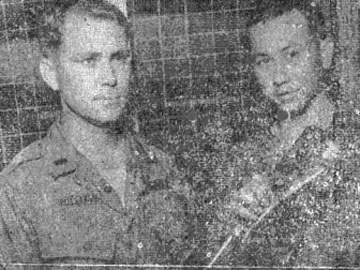 |
SURE SHOT - PFC Earl Lee Huff was providing security on a patrol when he was attacked by a king cobra. 1st Lt Ramon T. Pulliam shot the snake and PFC Huff's M-16 just as it was about to strike. |
Page 8 TROPIC LIGHTNING NEWS October 21, 1966
Mech. Men Shine in Operation
Two division soldiers saved their comrades by heroic actions during a recent
operation in the Ho Bo Woods, 30 miles northwest of Saigon.
Specialists 4 Norman S. Petit, 20, of Suffern, N.Y., and Roy A. Love, 21, of
Mountain Home, Idaho, of Co. B, 1st Bn. (Mech.), 5th Inf., destroyed a Viet Cong
bunker, claymore mines and a tunnel complex during the action.
The company, on a search-and-destroy operation, encountered a row of stumps
the armored personnel carriers (APCs) couldn't pass. The men from the 1st
platoon dismounted. Specialists Peti and Love were in the lead when they came
upon a claymore mine.
Realizing it was set for command detonation, Specialist Petit shouted to the
men behind him to return to the APCs. He and Love cut the wires leading from
the mine.
Just as the other men had re-entered the APCs, another hidden claymore was
set off.
An automatic weapon fired at the two lone men from a heavily camouflaged Viet
Cong bunker 30 yards away. Returning fire as they maneuvered, the two men
assaulted the bunker, cutting wires on claymore mines as they advanced.
Specialist Love's weapon was hit by the enemy fire and rendered useless. Upon
reaching the bunker the men lobbed hand grenades through the open top.
When the smoke had cleared, the men discovered two dead Viet Cong and an
automatic weapon.
September Bad Month for PFC
September was a bad month for PFC Johnny F. Pugh, a 21-year-old automatic
rifleman with the division's 2nd Bn., 27th Inf., "Wolfhounds."
Or maybe it was a good month. At any rate, the point man for the battalion's
1st Squad, 2nd Platoon of Co. A was wounded twice in September, but neither time
seriously enough to be hospitalized.
PFC Pugh, from Albuquerque, New Mexico, was wounded the first time while
helping his squad clear a path through a wooded area near the division's base
camp at Cu Chi. A bangalore torpedo used in the operation detonated a booby
trap and sent a stray piece of metal into the infantryman.
"It was no big thing," said PFC Pugh. "I was bandaged and sent back to duty
without even leaving the field."
The second mishap took place on September 27. Occupying the squad's point
position, PFC Pugh missed a land mine planted in his path. The man behind him
stepped on the trap and PFC Pugh, about 10 feet away, was hit in the back of the
neck and right leg.
"I didn't even know I'd been hit," said PFC Pugh. "I got up and saw that the
man who stepped on the mine was still down. I used to be an ambulance driver in
Albuquerque and I ran back to see if I could help him.
"He was all right, but wounded in the legs. I ripped his pant-legs open and
bandaged him up while the medic made his way up from our rear. My squad leader, who was helping me,
mentioned that there was some blood on my neck and I realize that my neck and
leg felt kind of hot."
Both of the men were evacuated to the 7th Surgical Hospital at the division's
base camp. PFC Pugh's buddy was hospitalized while he was sent back to his unit
after receiving a few stitches.
"I guess I earned my pay that month," PFC Pugh said.
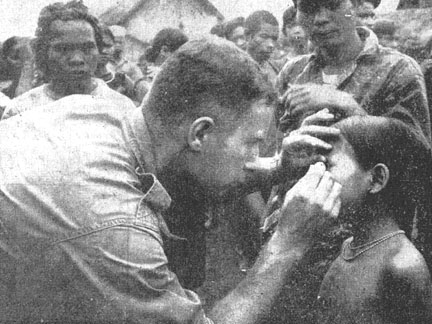 |
FORESIGHT - Lt. Larry A. Castignelo, a civil affairs officer with the 3rd Brigade, applies eye drops to treat an eye infection during a recent sick call conducted in a Montagnard village, in the central highlands. The eye was cured in three days. (Photo by 1st Lt. Peter J. Wascher) |
PFC's Heroism Wins Silver Star
PFC George E. Butler received the Silver Star from Brig. Gen. Glenn D.
Walker, commander, during ceremonies at Pleiku.
C Trp., 3rd Sqdn., 4th Cav., was called out for formation where the guidon
bearer and mascot horse stood side-by-side.
After the award ceremony, Gen. Walker gathered the men around him and said,
"Silver Stars are not just given away. It's our country's third highest award
for valor and I am more than proud to present it to PFC Butler."
"There has never been an occasion when this unit has been called upon to do a
job, and hasn't performed it to the best of its ability."
The citation stated that on July 3, while participating in Operation "Paul
Revere," Butler was serving as a machine-gunner aboard an armored personnel
carrier (APC) when attacked by a North Vietnam Army force using anti-tank
weapons and mortars.
While returning the hostile fire with his M-60 machine gun, Butler received
serious wounds in his side and stomach.
He continued to fight until an anti-tank rocket set his APC ablaze.
Butler dismounted the vehicle, with his M-60 providing cover fire, enabling
others of the patrol to move from the killing zone. Then, ignoring his personal
safety, he half-carried and half-dragged a wounded infantry company commander to
safety.
| STAR - PFC George E. Butler receives the Silver Star from Brig. Gen. Glenn D. Walker during ceremonies at Pleiku. (Photo by PFC John Newman) |
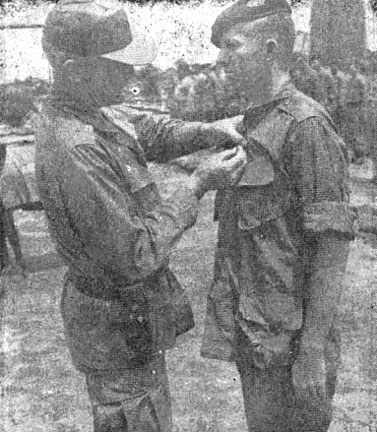 |
Thanks to:
The 25th Infantry Division Museum for providing the volume of 1966 Tropic
Lightning News,
Ron Leonard, 25th Aviation Battalion for finding and mailing them,
Kirk Ramsey, 2nd Bn., 14th Inf. for creating this page.
This page last modified
11-17-2007
©2007 25th Infantry Division Association. All rights reserved.